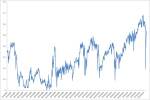For the past couple of weeks, I have been writing about how I think, ultimately, we will not go over the fiscal cliff. I have based my views on the need for both parties—for their own good and for the good of the country—to actually compromise and solve the problem.
And the need for some sort of deal is increasingly apparent, as I believe, based on the facts at hand, that the damage done to the economy may be well in excess of the 4 percent of GDP that the actual tax increases and spending cuts amount to. About two-thirds of that 4 percent is made up of tax increases; the rest is spending cuts. Economic studies have shown that the multiplier for tax increases is between 2 and 3, while that of spending cuts is between 1 and 2. Combined, using a multiplier of 2.5 for the tax increases and 1.5 for the spending cuts, we might reasonably assume a 7-percent to 8-percent hit to GDP.





